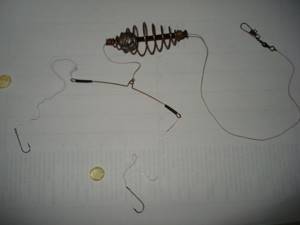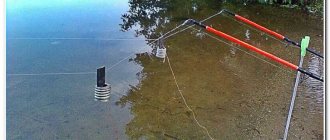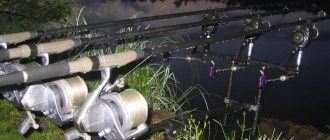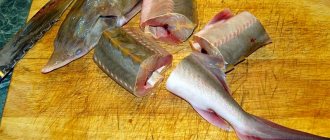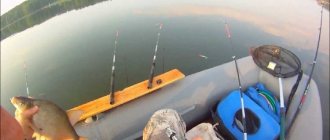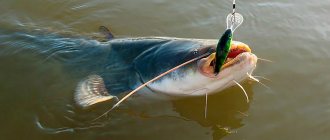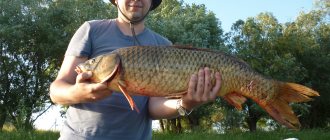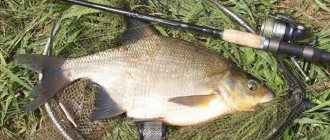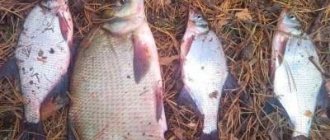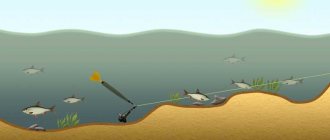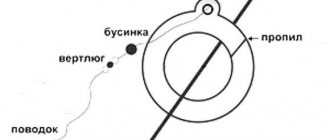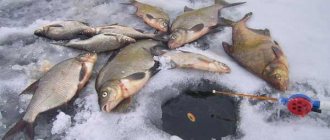Donka
This is a special type of fishing rod. The design is a symbiosis of a fishing line with a load and a leash with a hook. The tackle is thrown into the water, where it is fixed with a sinker. It has several varieties:
- snack;
- rubber;
- donka with a float;
- feeder equipment;
- running gear;
- makushatniki (“satellites”);
- returnable;
- winter.
For winter fishing, a different design is used. The nod, to which the reel is attached, is attached to a fishing rod made of hardwood. The fishing rod crashes into the ice, where it freezes.
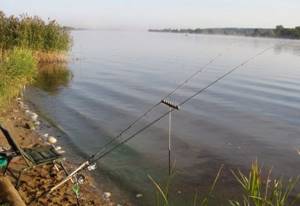
At the moment when the fish swallows the bait, the nod shudders and begins to swing continuously. His movements can be observed from a distance.
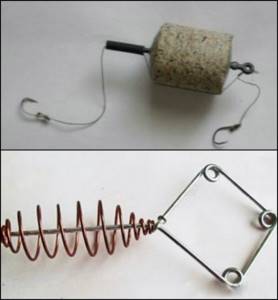
It should be noted that bottom tackle is easy to make with your own hands.
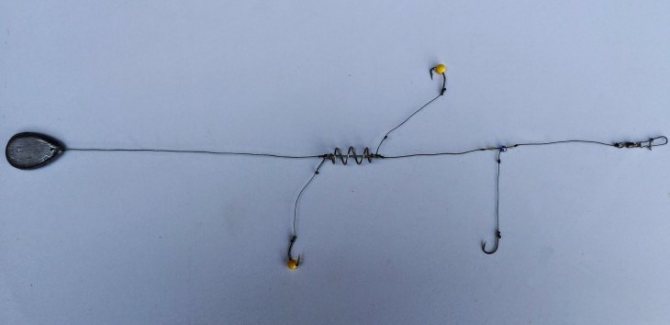
How to fish with donka
The technique of catching fish on a donk looks like this:
- First you need to mix the bait mixture. Its components are selected depending on the type of fish being caught. After mixing the complementary foods, you need to wait half an hour so that it is well saturated with water.
- While the bait mixture is ready, the fisherman must measure the depth at the future fishing site. To do this, you should use a special marker float or conventional stepped wiring, with the help of which you can determine holes, depth differences and the general bottom topography.
- The initial feeding of fish is done with a donk with a feeder. It needs to be filled with complementary foods so that the mixture is not very dense in the feeder. Feeding additions need to be made from five to twenty. In this case, when the feeder touches the bottom, you should sharply hook the fishing rod so that the mixture falls out of the feeder.
- Next you need to wind the fishing line and fill the feeder tightly.
- Cast and place the rod on the stand.
- Stretch the fishing line and connect the bite alarm.
- If there was no bite within fifteen minutes, recast.
- If there are no bites for more than forty minutes, you should change the bait and the fishing location.
- When biting, you should bring the catch closer to the shore and hook it.
Which fish to choose?
First of all, the inhabitants of lakes and rivers look for food at the bottom. Among them: perch, catfish, ide, carp, crucian carp, and others. The donka was created specifically for catching them.
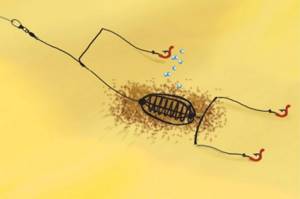
Instructions on how to choose bottom tackle
When choosing a donkey, several factors are taken into account. They significantly affect fishing. For fishing to be successful, you need to pay attention to:
- Characteristics of the reservoir (is there a current, is the water calm).
- Availability of fish to be caught.
- The strength of the current.
- Distance (fishing from the shore, fishing from a boat).
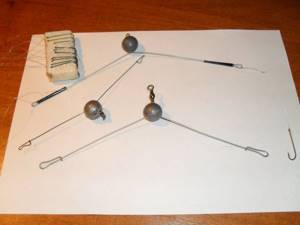
Bottom fishing can have obstacles. Driftwood and bottom algae can interfere with successful fishing. However, there are special techniques that help get rid of obstacles.
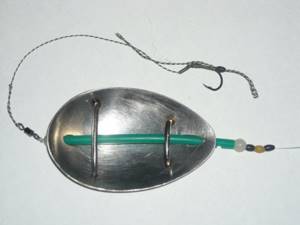
Donk fishing
Donk fishing has the following advantages:
- makes it possible to fish in reservoirs with both strong and weak currents;
- can be fished at a variety of depths;
- With a bottom you can cast bait mixture over a fairly long distance (up to one hundred and twenty meters), which is very convenient;
- when catching fish, you can feed;
- Both electronic and mechanical alarms can indicate bites;
- Donka can be fished in deep-sea holes at very great depths.
Disadvantages of catching fish on a donk:
- possible snags of the gear on snags, algae, etc.;
- not used for catching fish that live in the upper layers of reservoirs, but only at depth;
- cannot be used in reservoirs where there are a lot of snags;
- not used on mountain rivers with a large slope.
Donka is used to catch the following types of fish:
- catfish;
- burbot;
- carp;
- bream;
- chub;
- crucian carp;
- zander;
- pike.
You can fish with donka in spring, summer and autumn, but its use shows the best results in summer and autumn.
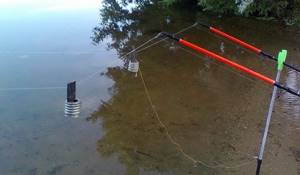
Evolution
When the first examples of bottom gear appeared, they did not have reels, and some did not have rods. The line had to be wound onto the reel. It was also difficult to make long casts.

The situation was radically changed by the appearance of improved bottom tackle: with telescopic and plug-in rods. Novice fishermen began to use new models. Experienced ones preferred homemade devices.

Zakidushka
How to make bottom tackle? It is the bait, the ancestor of all types of gear for bottom fishing, that you can make yourself. A sinker is attached to a piece of fishing line, which is placed at the end. The design includes 3-4 leashes with hooks.
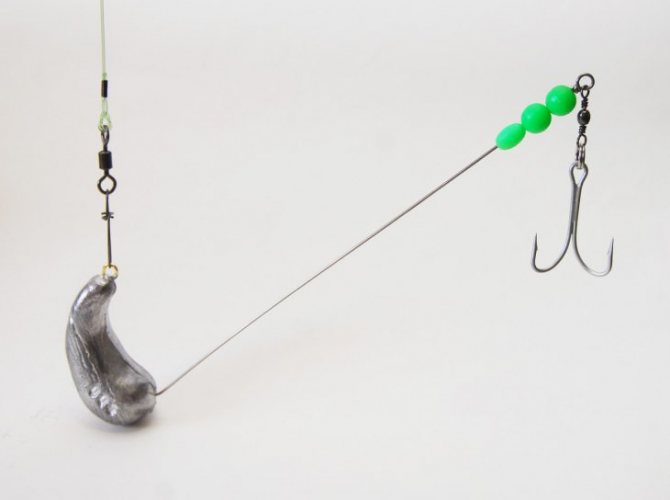
In the old days, a hook was a fishing line wound on a reel made of wood. During fishing, it stuck into the sand. After casting, the line was stretched and fixed on the stand. A bell attached to an elastic band rang when a fish grabbed the bait. Instead of a fishing rod, many used long sticks, pointed at one end. They were stuck into the sand, providing support for the structure.
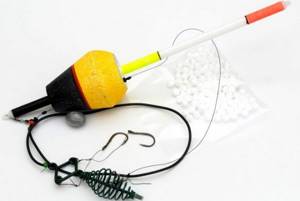
Features of donk fishing depending on the type of fish
Catching chub on a donk has the following features:
- The chub begins to swim more actively only from eight o’clock in the morning. Before lunch, he swims to well-warmed areas of the reservoir, where you need to look for him. After five o'clock in the evening until eight it stops biting, but after nine o'clock until midnight it becomes active again.
- Catching chub at night is ineffective, since at this time it practically does not bite.
- Catching this fish on the bottom brings good results, since the chub loves to collect various porridges from the bottom of reservoirs, and as a result, sooner or later it gets caught on the hook.
- The chub has very acute hearing, so when catching it on a donk you should be very careful and sit quietly. Even the slight sound of broken branches underfoot can scare away this fish. Besides. The chub has excellent eyesight, so the fisherman must approach the fishing rod very carefully and, if possible, sit behind bushes or trees when fishing.
- The chub is a fairly strong fish and can resist when fished, so the fisherman must always be prepared for sharp turns of the fish. Because of this, it is recommended to use strong fishing line and hooks that the chub cannot bend.
Fishing for crucian carp on a dock has the following features:
- It is better to cast gear for crucian carp in the middle of the reservoir. This will make it possible to catch larger crucian carp that do not swim to the shore.
- Crucian carp usually swim at depth, so it makes no sense to cast gear into shallow water.
- It is very effective to catch crucian carp on a donka in a large current.
- When catching crucian carp on a donk, you cannot do without a high-quality electronic bite alarm.
- Crucian carp bite best before dawn and at sunset. In addition, sometimes it comes out to feed at night.
- It is advisable to feed crucian carp the evening before the upcoming catch.
If you want to find out in more detail what they use to catch crucian carp, you can read our article.
Catching carp on a donk has the following features:
- Carp is the most timid and cautious river fish, so the fisherman must make every effort to remain unnoticed by it.
- Carp constantly migrates from one part of the reservoir to another. This is due to changes in weather conditions. When there is a sharp cold snap, this fish goes to deep holes, and when it warms up, on the contrary, it swims closer to the shores.
- Carp can swim both against the current and behind it. This should be taken into account when casting a donkey.
- You should know that carp sometimes swim into very deep parts of the reservoir (more than twenty meters), so you should not be afraid to cast gear to this depth.
- Before catching, the carp needs to be fed for several days in a row in order to accustom it to a certain place in the reservoir.
Catching carp on a donk has the following features:
- Carp is a very strong fish, so all bottom gear for catching it must be powerful.
- You need to feed the carp all the time in small portions, since it will not stay in one place for a long time if it does not see enough food.
- You need to constantly throw the feeder and complementary food in one place so that the carp does not swim far from the required area.
- Corn is considered the best bait for carp.
Catching catfish on a donk has the following features:
- Catfish should be caught near deep holes where this fish settles.
- It is recommended to use several bottom fishing rods at once to catch catfish in order to place them in different parts of the reservoir (under trees, near reeds, etc.).
- It is imperative to use a very stable stand for the fishing rod so that a large catfish does not drag it down when biting into the water.
- When fishing, you should use a landing net, otherwise a large catfish simply cannot be pulled out of the water.
When the cold comes
Winter bottom tackle is not very often used by fishermen. But you can also catch a lot of fish with it, since in winter it feeds at the bottom. The structure consists of the following components:
- fishing rod (fishing rod);
- nod;
- coil;
- fishing line;
- equipment
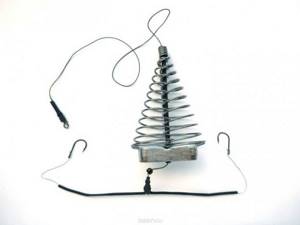
The load is taken sliding, weighing 10-15 g, in the shape of an olive. It is threaded through a line whose diameter should vary from 0.16 to 0.2. With a rapid current, the weight of the load can be 20 g. The fishing line is also thicker.
